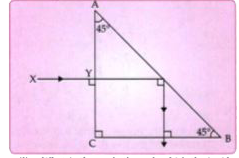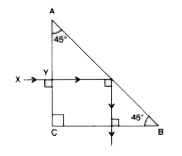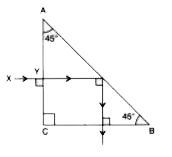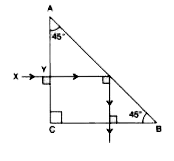Show with the aid of a ray diagram, how a right angled isosceles prism can be used to invert the rays. (a) How sould the rays fall on the prism ?
(b) Which phenomenon is responsible for this action of prism? (c) What is the nature of the image in relation to the object ?
To solve the problem of how a right-angled isosceles prism can be used to invert rays, we will follow these steps:
Step 1: Understanding the Prism
A right-angled isosceles prism has two equal sides and a right angle between them. The hypotenuse acts as the entry and exit surface for light rays.
Step 2: Drawing the Ray Diagram
1. Draw the Prism: Start by sketching a right-angled isosceles prism. Label the vertices as A, B, and C, where A and B are the ends of the base, and C is the apex of the right angle.
2. Incident Ray: Draw an incident ray approaching the prism from the left side, striking the hypotenuse (AC) at an angle. Label the point of incidence as D.
3. Refraction at the Hypotenuse: Show the ray bending as it enters the prism. This bending occurs due to refraction, and the ray will continue inside the prism towards the base (BC).
4. Internal Reflection: When the ray reaches the base (BC), it will undergo total internal reflection (TIR) because the angle of incidence is greater than the critical angle.
5. Emerging Ray: After reflecting off the base, draw the ray emerging from the hypotenuse (AC) back into the air. Label the emerging ray.
6. Image Formation: Mark the original object as AB and the inverted image as A'B'.
Step 3: Answering the Questions
(a) How should the rays fall on the prism?
- The rays should fall on the prism through the hypotenuse (AC) at an angle that allows for refraction into the prism.
(b) Which phenomenon is responsible for this action of the prism?
- The phenomenon responsible for the inversion of the rays is Total Internal Reflection (TIR).
(c) What is the nature of the image in relation to the object?
- The nature of the image is that it is inverted in relation to the object.
Final Summary
The right-angled isosceles prism inverts rays through refraction and total internal reflection, resulting in an inverted image compared to the original object.
---
A right-angled isosceles prism has two equal sides and a right angle between them. The hypotenuse acts as the entry and exit surface for light rays.
1. Draw the Prism: Start by sketching a right-angled isosceles prism. Label the vertices as A, B, and C, where A and B are the ends of the base, and C is the apex of the right angle.
2. Incident Ray: Draw an incident ray approaching the prism from the left side, striking the hypotenuse (AC) at an angle. Label the point of incidence as D.
3. Refraction at the Hypotenuse: Show the ray bending as it enters the prism. This bending occurs due to refraction, and the ray will continue inside the prism towards the base (BC).
4. Internal Reflection: When the ray reaches the base (BC), it will undergo total internal reflection (TIR) because the angle of incidence is greater than the critical angle.
5. Emerging Ray: After reflecting off the base, draw the ray emerging from the hypotenuse (AC) back into the air. Label the emerging ray.
6. Image Formation: Mark the original object as AB and the inverted image as A'B'.
(a) How should the rays fall on the prism?
- The rays should fall on the prism through the hypotenuse (AC) at an angle that allows for refraction into the prism.
- The phenomenon responsible for the inversion of the rays is Total Internal Reflection (TIR).
- The nature of the image is that it is inverted in relation to the object.
The right-angled isosceles prism inverts rays through refraction and total internal reflection, resulting in an inverted image compared to the original object.
Topper's Solved these Questions
- REFRACTION OF LIGHT AT PLANE SURFACESBook:ICSEChapter:REFRACTION OF LIGHT AT PLANE SURFACESExercise:EXERCISE-4(A)
Explore 31 Videos
- REFRACTION OF LIGHT AT PLANE SURFACESBook:ICSEChapter:REFRACTION OF LIGHT AT PLANE SURFACESExercise:EXERCISE-4(A) MULTIPLE CHOICE TYPE
Explore 3 Videos
- REFRACTION OF LIGHTBook:ICSEChapter:REFRACTION OF LIGHTExercise:DIAGRAM BASED MCQ:
Explore 5 Videos
- REFRACTION THROUGH A LENS Book:ICSEChapter:REFRACTION THROUGH A LENS Exercise:EXERCISE-5(D) (MULTIPLE CHOICE TYPE)
Explore 2 Videos
Similar Questions
Draw a diagram of a right angled isoscels prism which is used to make an inverted image erect.
View SolutionDraw a ray diagram to show a right angled isosceles prism may be used to ''bend the path of light rays by 90∘.
Write the necessary condition in terms of the refractive index of the material of this prism for the ray to bend to 90∘.
View Solution
Knowledge Check
A total reflecting right angled isosceles prism can be used to deviate a ray of light through :
A30∘B60∘C75∘D90∘
Show with the help of a diagram how a total reflecting prism can be used to turn a ray of light through 90∘. Name one instrument in which such a prism is used.
View SolutionA ray of light XY passes through a right angled isosceles prism as shown below.
Name the instrument where this action of prism is put into use.
View SolutionA ray of light XY passes through a right angled isosceles prism as shown below:

Which prism surface will behave as a mirror ?
View SolutionA ray of light XY passes through a right angled isosceles prism as shown alongside.
Which prism surface will behave as a mirror ?

View SolutionDraw a ray diagram to show how a convex lens can be used as a magnifying glass.
View SolutionA ray of light XY passes through a right angled isosceles prism as shown alongside.
Name the instrument where this action of prism is put into use.

View SolutionA ray of light XY passes through a right angled isosceles prism as shown alongside.
What is the angle through which the incident ray deviates and emerges out of the prism ?

View Solution

